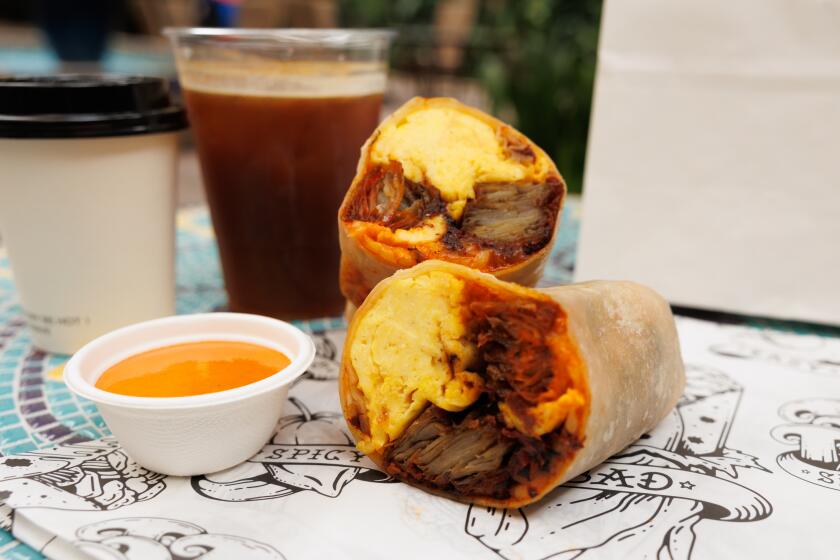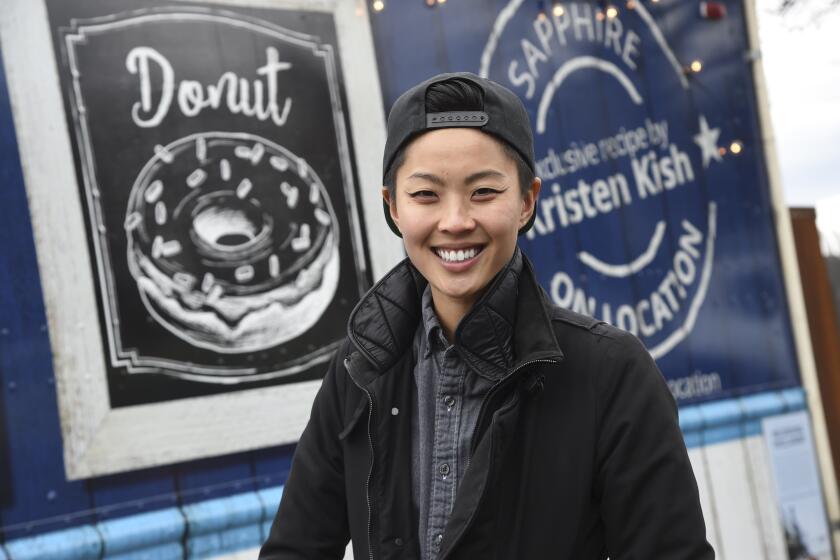Midnight at the Oasis : Wholesale: No matter where the vegetable or fruit you eat originated, chances are it has passed through one of the wholesale markets just east of Downtown.
- Share via
“Have a good day, dear,” sings the blase young waitress at Vickman’s Cafeteria, and goes back to trading wisecracks with five coffee-drinking policemen.
Have a good day, indeed--it’s 3:20 a.m. People here in the Produce District are unsettlingly attuned to a midnight schedule (yes, Vickman’s does serve decaf at 3:20 in the morning). Outside Vickman’s door there’s nothing but dark streets echoing the scrape of your footsteps.
For the record:
12:00 a.m. July 18, 1991 For the Record
Los Angeles Times Thursday July 18, 1991 Home Edition Food Part H Page 39 Column 3 Food Desk 2 inches; 43 words Type of Material: Correction
Name Change--”Midnight at the Oasis” (July 11) incorrectly referred to the 7th Street Market by its former name, L. A. Union Terminal Market. The downtown produce market was purchased from the Southern Pacific Railroad in 1988 by Lowe Enterprises and officially renamed the 7th Street Market at that time.
A block east of the cafeteria, though, Central Avenue is ablaze with light, swarming with movement. Two major produce markets meet here. North of 8th Street is the Los Angeles Union Terminal Market, built in 1918 and owned by the Union Pacific Railroad (a rail spur still runs alongside it).
It’s a sort of narrow, block-long courtyard formed by wholesale produce stalls, which are basically warehouse rooms. Trucks from the farm country are offloading fruits and vegetables from outside the building and trucks heading for restaurants and markets are on-loading in the yard. Tonight it smells distinctly of melons.
South of 8th Street is the Los Angeles Wholesale Produce Market--a modernistic dazzler, a virtual Disneyland among produce markets, completed almost exactly five years ago. It’s immense. Together with the Terminal Market, it occupies nearly all the land between 7th Street and Olympic from Central to Alameda, and does so in grand style. No boring blank facades on Central; the walls are covered with freeway-type murals of fruits and vegetables.
Instead of resembling a courtyard, like the Terminal Market, it takes the form of an open field of wide paved aisles separating the wholesalers’ stall buildings. Looking down one of the block-long concrete loading docks that front the spacious storage rooms, you get the odd feeling of being in an airport. It may have to do with the signs in front of stall after stall that belong to major wholesalers. Something about a row of signs reading GIUMARRA GIUMARRA GIUMARRA is reminiscent of an airline ticket counter.
Or maybe it’s the sight of wide, runway-like aisles flood-lit in the dead of night. The semis lumbering into the yard and pulling up to the docks look like jetliners, somehow. Even high-sided stake trucks do, or so it seems at this unearthly hour.
Surprisingly, this market has lots of wide concrete ramps with blue Handicapped Access signs. It seems all too politically correct until you’re nearly knocked over by a worker whizzing a handcart full of pineapple down to the yard and up onto another stall row. Some wholesaler has just had to call on another for five crates of pineapple, toot sweet, to fill a customer’s order. There’s not a wheelchair in sight--the ramps are really for handcart and forklift access.
On the dark west side of Central Avenue, the old Central Market still stands, dwarfed by the produce Disneyland across the street. It’s a wholesale/retail operation handling meat and dairy products as well as fruits and vegetables, and alone among the neighborhood’s markets it sports an illuminated sign reading “PRODUCTOS LATINOS PUBLIC INVITED.”
There’s another major produce market some blocks southwest of this conglomeration, running along the west side of San Pedro Street between 9th and 12th. It’s the oldest of the markets, the City Market (despite the name, privately owned, like the others). It was built in 1909 on a spot where farmers were hauling their goods in wagons a hundred years ago, when Los Angeles was smaller than Oxnard is today.
The buildings bear their age with a weary gallantry. The yard floor is full of asphalt patches; tumbleweed and pampas grass grow in the pavement outside. And it has narrow, pre-automobile dimensions.
It’s a stall-lined courtyard like the Terminal Market, but three blocks long, with two rows of roofed sheds running down the middle. Small trucks can enter--they drive onto hydraulic platforms that lower them until the floor of the truck is even with the yard, for easy offloading--but semis can’t enter until 10 a.m., and may have to be offloaded at the clogged street entrances. In the darkness, you can see semi trucks standing out on San Julian Street, shuddering from the vibration of their air conditioning, awaiting their turn.
The official names of the produce markets are: L. A. Union Terminal, City, Central and L. A. Wholesale Produce. But people in the business don’t refer to them that way. They call them the 7th Street Market, the 9th Street Market, the Mexican Market and the New Market. And since the 7th Street Market and the New Market are next to each other, swampers often don’t distinguish them at all.
The word swamper is loggers’ lingo; “to swamp” originally meant to cut a road through a forest (a “swamp”) by chopping down trees, and then it took on the meaning of hauling felled logs. In the produce markets, a swamper hauls crates in and out of trucks, perhaps using a hydraulic jack to move them between yard level and the loading dock, and stacks them to order.
Swampers come to work early, by produce market standards. The wholesalers open any time between midnight and 3 a.m., but the swampers have to be down here well before midnight to hustle assignments from the produce truck drivers. A driver gets a budget from his employer, usually a produce broker,to pay $65 to $80 for unloading a standard truckload, and if a swamper hustles, and is lucky, he can make around $500 a week.
But there’s a lot of waiting around in the swamping business. The truck driver may not be able to unload right away, and in that case he is likely to go up to the truck stop at 7th and Alameda which will hold a truck until needed. Only when he comes back can the swamper start work. If you’re talking to a swamper, he may well stop in the middle of a sentence, shout, “There’s my truck!” and be off like a shot.
Ken Martin has worked as a swamper (or lumper, a synonymous term) since he came here from Washington, DC, about a year ago. “I’m unloading tomatoes tonight,” he says. “I’ve stacked for all these guys. Cal Fruit and Perricone (in the New Market), they have all the citrus. W. Fay (in the 7th Street Market) handles a little of everything.” He’s a cheery guy, but beginning to get a little edgy--it’s 4 a.m. and he’s still waiting for his tomato job to start.
A friend of his who prefers to be known as “L. A.” (“that’s what everybody calls me”) has been a swamper for eight years. “We’re the backbone of the market,” says “L. A.,” showing his callused hands. “We move everything that goes through here.”
“L. A.” is trying to organize a crew of regular swampers accepted by the market in order to counter the competition he says has been coming from nearby Skid Row. “These crack heads,” he says, “they come in and they’ll work cheap. They’ll take anything just so they can smoke that rock.
“But when the drivers hire them, a lot of times they’ve got to hire us later to straighten out their stacking. Take a look down there--it’s a real mess.”
Another problem for him these days is that some drivers may bring along their own family members to do the swamping. “You can understand it,” he says philosophically. “Times are hard.” (And some day there may be no jobs for swampers--in the new market, produce is handled by the wholesalers’ own employees when it comes palletized and can be moved around with forklifts.)
The truck drivers themselves add another element to the ethnic diversity of the market. At 4:15 a.m., a Chinese waitress at May Wah Restaurant, conversing in Spanish with a wholesaler’s employee, looks up and smiles at a departing truck driver, who drawls, “You take care, hear?”
A truck driver might possibly be delivering for a particular farm, but these days 90% of delivery to the produce markets is arranged by brokers. (Farmers who want to haul their own produce to market usually go to the many farmers’ markets these days.) Brokers may work out in the farm country or have offices in the produce district, like other ancillary businesses such as the refrigerated storage companies and the various financial services.
The center of the action is the wholesalers themselves. On a busy night, they are surrounded by a swirl of swampers and buyers and forklifts, a jangle of ringing phones. They stand between the brokers, who deal directly with the farmers, and the buyers--the supermarket chains, the purveyors who middleman produce to restaurants and institutions, and the secondary jobbers or “route men” who deliver in bobtail trucks to restaurants and mom and pop stores. But this particular night falls in a slack season after the July 4 holiday, and things are a little slow at 5 a.m.
Roger Furukawa of F & W Produce sits under a shed roof in the City Market among crates of produce opened for any potential customer to inspect: melons, cucumbers, cilantro, bright yellow bell peppers and red-ripe serranos , a whole summer smorgasbord scattered under the lights. With a C & W station moaning in the background, he explains how he works, speaking in a rich Central Valley drawl.
“I go to bed at 5 and get up again at 11:30 or midnight and come down here. The market opens 2 a.m. to 10, but I’m here till 2 (p.m.). Sometimes I go out in the afternoon to talk to my farmers.
“I’ve been here 27 years. I guess you could say I was born into it.” His father was in the business before World War II. After being interned with the rest of the Japanese during the war, his father didn’t go back into produce, but Roger did. “After graduating high school, I started driving a truck for a produce hauler, and I got back into the business that way.
“I’ll find anything for a customer,” he says matter-of-factly. “If I don’t have it, I know where it is. I know what’s in the market. I have a few people I know, I might call a farmer direct. It’ll cost a little more because I’ll add my commission on top, but I can find anything.”
There’s a mysterious quality, almost the sense of a secret society, about a business where people work while the city sleeps. It’s beginning to fade now, though. Prosy dawn light is softening the outlines of sheds, crates and handcarts. The sky is turning pearly and there’s a faint iridescence to the high streaks of cloud. Have a good day.
More to Read
Eat your way across L.A.
Get our weekly Tasting Notes newsletter for reviews, news and more.
You may occasionally receive promotional content from the Los Angeles Times.










